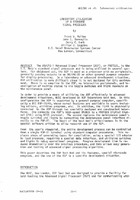| dc.description.abstract | The AN/UYS-l Advanced Signal Processor (ASP), or PROTEUS, is the U.S. Navy's standard signal processor and is being utilized in several systems. For shipboard use, the ASP is used as a processor with no peripherals, generally passing outputs to an AN/UYK-20 or other gen~ral purpose computer for display processing. In a laboratory or advanced development situation, ASP utilization is m~re difficult since it is not designed for this environment. There is no compiler in the ASP, no interactive peripherals, and investigation of machine status is via toggle switches and light readouts on the maintenance panel. In order to provide a means of utilizing the ASP effectively in advanced development situations, NUSC developed an ASP laboratory test bed. In this configuration the ASP is supported by a general purpose computer, specifically a DEC PDP-ll/45, whose normal features are available to users including editors, utilities programs, etc. In addition, the 11/45 is physically connected to the ASP through two specially designed and constructed interfaces. One connects the PDP's high-speed UNIBUS to a PROTEUS Digital Channel (PDC) using NTDS protocol. The second replaces the maintenance panel's toggle switches and lights by connecting the maintenance panel interface directly to the PDP-ll. The heart of the test bed's effectiveness is in the special software written to allow research use of the ASP. From the user's viewpoint, the entire development process can be controlled from a single PDP-ll terminal using standard computer procedures. This replaces steps of generating tapes for compilation, using a special I/O adapter to load programs, requiring a special data interface, and utilizing switches and lights to debug operational prog~ams. Program development time is reduced dramatically over the previous procedure, and this allows easy generation and testing of advanced signal processing algorithms. This paper describes the ASP Test Bed and its features, special microcode programs, and the use of the ASP in aspecific development situation. | |
